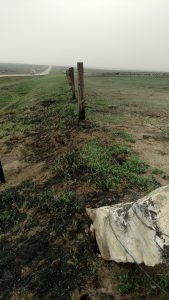By Keith Harmoney, range scientist, Hays
I was recently asked how the drought of 2022 will affect forage growth in 2023 and how drought-stricken pastures should be managed during the fall and winter prior to next growing season. These questions point me to results of a grazing study during the driest year on record at the KSU Agricultural Research Center at Hays in 1956. Looking back at 1956 and nearly 80 years of grazing studies to date, the stocking rate study being conducted that year also produced the lowest pasture yields that have been recorded at the Research Center.
In fact, grazing animals were removed in August of 1956 from the high stocking rate treatment of the study because animals simply did not have enough forage left in pastures to graze through October, the time that animals were supposed to be removed according to the study protocol. The heavy stocking rate pasture was essentially a tabletop. However, the driest year on record at Hays in 1956 was followed the next year in 1957 by an above average season of precipitation. In 1957, all of the pastures of the different stocking rate treatments in the study responded with above treatment average forage production from the above average precipitation, even in the heavy stocked pastures.
Continue reading “Learning from droughts in the 1930s and ’50s”
